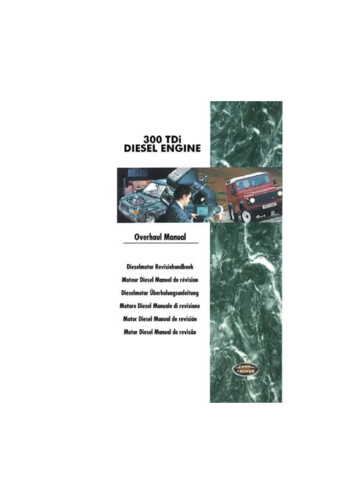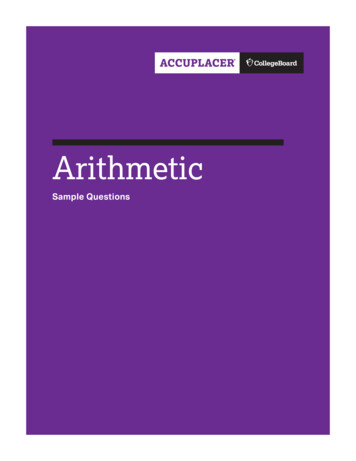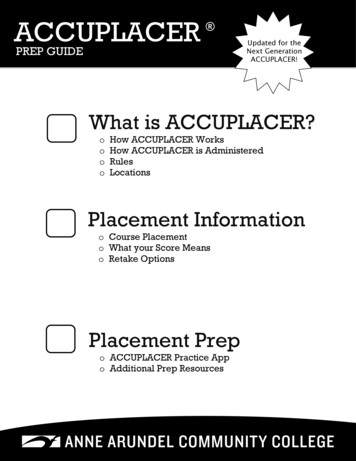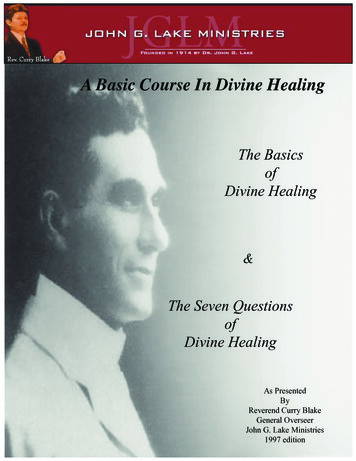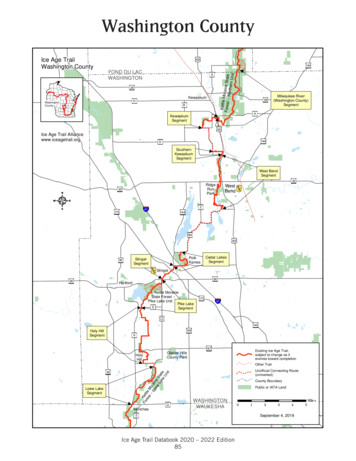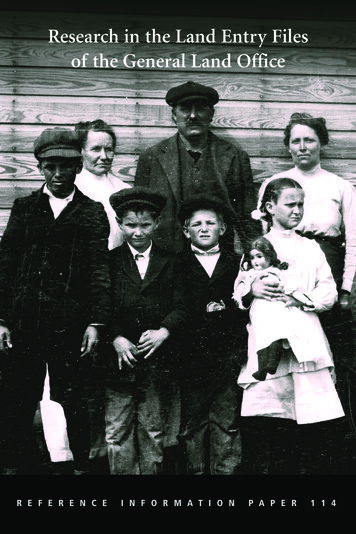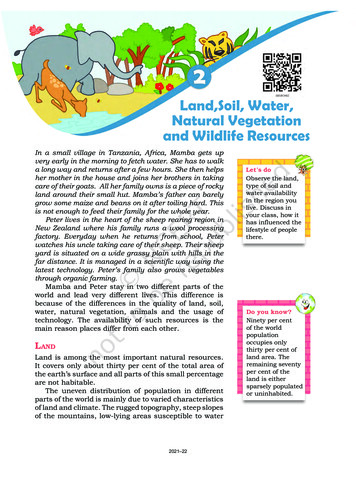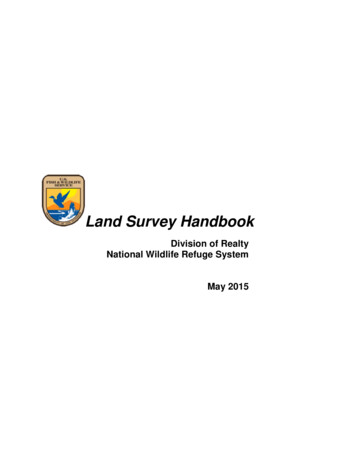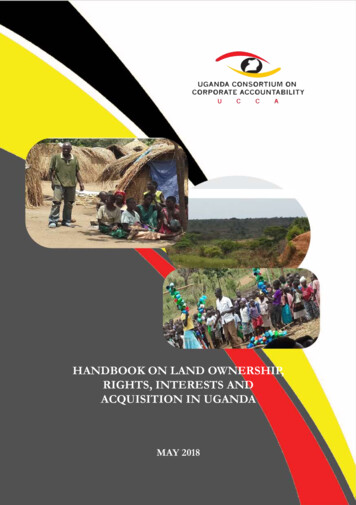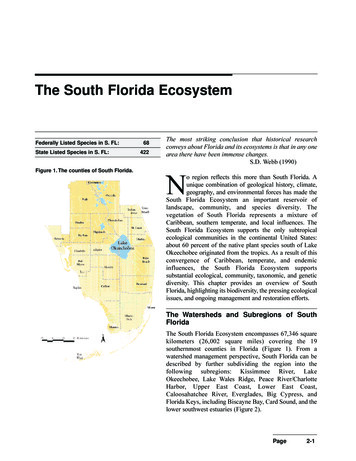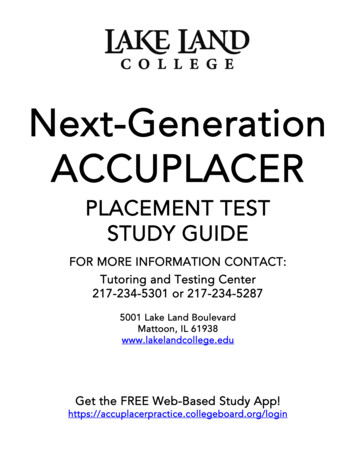
Transcription
Next-GenerationACCUPLACERPLACEMENT TESTSTUDY GUIDEFOR MORE INFORMATION CONTACT:Tutoring and Testing Center217-234-5301 or 217-234-52875001 Lake Land BoulevardMattoon, IL 61938www.lakelandcollege.eduGet the FREE Web-Based Study gin
Lake Land College Placement Testing Policy Students will be mandatorily placed into appropriate courses as determined by scores on theLake Land College placement test/ACT/SAT test and program requirements.Students may retest once in each skill area--limit of two sets of Lake Land College test scoreswithin a four-year period.Initial placement test is free; minimal retest fee.Students with special needs can make special arrangements for placement testing by contactingthe Coordinator for Student Accommodations at 217-234-5259.How well you do may be affected by how well you follow instructions. A short tutorial withsample questions will show you how to take the test. Be sure you understand test instructions beforebeginning.Take your time and work at your own speed. There is no time limit. Scores are determined by thenumber of correct answers. It is to your advantage to take your time.* Placement in courses is based upon test scores.* Placement test scores are part of the selection criteria for special admissions programs.Skill areas include reading, writing (English), and math: Next-Generation Reading assesses the test-taker’s ability to derive meaning from a range of texts and todetermine the meaning of words and phrases in short and extended contexts.Next-Generation Writing evaluates a test-taker’s ability to revise and edit multi-paragraph text.The mathematics tests cover quantitative reasoning, algebra, statistics, and functions.Tips for Taking ACCUPLACER Tests1. Relax! The ACCUPLACER tests are designed to help you succeed in school. Your scores helpdetermine which courses are most appropriate for your current level of knowledge and skills.2. You will be able to concentrate better on the test if you get plenty of rest and eat properly beforethe test. Please arrive a few minutes early so you can find the testing area, restrooms, etc., andhave time to gather your thoughts before the test begins.3. Be sure you understand directions before beginning each test.4. Read each question carefully until you understand what the question is asking. If answering anitem requires several steps, be sure you consider them all.5. Be sure to answer every item. You are not penalized for guessing. Your score will provide moreuseful placement information if you answer every item, even if you guess.6. Don't be afraid to change an answer if you believe that your first choice was wrong.7. If you have a problem or question during the test, raise your hand, and the test proctor will helpyou. Although they cannot answer test questions for you, they can help you with other issues.
Next-Generation Reading TestThe Next-Generation Reading test is a broad-spectrum computer adaptive assessment of testtakers’ developed ability to derive meaning from a range of prose texts and to determine themeaning of words and phrases in short and extended contexts. Passages on the test cover arange of content areas, writing modes, and complexities (relatively easy to very challenging).Both single and paired passages are included. The test pool includes both authentic texts(previously published passages excerpted or minimally adapted from their published form) andcommissioned texts (written specifically for the test). Questions are multiple choice in formatand appear as both discrete (stand-alone) questions and as parts of sets of questions builtaround a common passage or passages. 20 questionso 12 discrete questions—either single-sentence vocabulary or based on a shortpassageo 8 set-based questions—presented in two sets of fourSkills Assessed: Ability to derive meaning from 4 main content categorieso Information and Ideas (reading closely, determining central ideas and themes,summarizing, understanding relationships)o Rhetoric (analyzing word choice rhetorically, analyzing text structure, analyzingpoint of view, analyzing purpose, analyzing arguments)o Synthesis (analyzing multiple texts)o VocabularyText Typeo Authentico Informationalo LiteraryText lengtho 75 - 400 wordso Single texts (75 - 400 words)o Paired texts ( 400 words across 2 texts)Range of Content Areaso Careers/history/social studieso Humanitieso Scienceo Literary texts are either fiction or literary nonfictionWriting Modes (text types)o Narrativeo Informative/Explanatoryo Arguments3
Sample Questions(11) And now tonight, with twenty-four hours togo, they had somehow managed to bring it of.(12) Giddy in the unfamiliar feel of make-up andcostumes on this frst warm evening of the year, theyhad forgotten to be afraid: they had let the movementof the play come and carry them and break like awave; and maybe it sounded corny (and what if itdid?) but they had all put their hearts into their work.(13) Could anyone ever ask for more than that?Directions for questions 1-14Read the passage(s) below and answer the questionbased on what is stated or implied in the passage(s) andin any introductory material that may be provided.In this passage, an amateur theater group called theLaurel Players is putting on its frst production.(1) Te Players, coming out of their various kitchendoors and hesitating for a minute to button theircoats or pull on their gloves, would see a landscapein which only a few very old, weathered housesseemed to belong; it made their own homes look asweightless and impermanent, as foolishly misplacedas a great many bright new toys that had beenlef outdoors overnight and rained on. (2) Teirautomobiles didn’t look right either—unnecessarilywide and gleaming in the colors of candy and icecream, seeming to wince at each splatter of mud,they crawled apologetically down the broken roadsthat led from all directions to the deep, level slabof Route Twelve. (3) Once there the cars seemedable to relax in an environment all their own, along bright valley of colored plastic and plate glassand stainless steel—KING KONE, MOBILGAS,SHOPORAMA, EAT—but eventually they had toturn of, one by one, and make their way up thewinding country road that led to the central highschool; they had to pull up and stop in the quietparking lot outside the high-school auditorium.From Richard Yates, Revolutionary Road. 1989 by RichardYates. Originally published in 1961.1.Te contrasts the narrator draws in sentences 1 and 2between the Players’ homes and the houses in the“landscape” and between the Players’ automobiles andthe “roads” are most likely meant to suggest that thePlayers’ homes and automobiles areA. old and neglectedB. modern and alienC. small but expensiveD. grand but unappreciated2.Based on the passage, which of the following mostaccurately characterizes the claim that “there was plentyof time to smooth the thing out” (sentence 8)?A. A comforting falsehood that the Players know to beuntrueB. An outright lie that the director persuades thePlayers to acceptC. An optimistic conclusion reached by outsideobservers watching an early rehearsalD. A realistic appraisal ofered by the director afercareful analysis of the play’s shortcomings3.Te descriptive language in sentence 10 is mainly intendedto reinforce the passage’s depiction of the Players’A. growing resentment of the director’s leadershipB. increasing reluctance to work as hard as they havebeenC. lingering doubts about their fellow cast membersD. persistent mood of despair regarding the play4.Te narrator most strongly suggests that which of thefollowing resulted in the transformation described inthe last paragraph?A. Te change in time of day during which rehearsalswere being heldB. Te greater frequency with which rehearsals werebeing scheduledC. Te shif in the director’s style from strict to moreforgivingD. Te break in routine occurring the day before thefrst performance(4) “Hi!” the Players would shyly call to oneanother.(5) “Hi! . . .” (6) “Hi! . . .” (7) And they’d goreluctantly inside.(8) Clumping their heavy galoshes around thestage, blotting at their noses with Kleenex andfrowning at the unsteady print of their scripts,they would disarm each other at last with peals offorgiving laughter, and they would agree, over andover, that there was plenty of time to smooth thething out. (9) But there wasn’t plenty of time, andthey all knew it, and a doubling and redoublingof their rehearsal schedule seemed only to makematters worse. (10) Long afer the time had comefor what the director called “really getting thisthing of the ground; really making it happen,”it remained a static, shapeless, inhumanly heavyweight; time and time again they read the promiseof failure in each other’s eyes, in the apologeticnods and smiles of their parting and the spastichaste with which they broke for their cars anddrove home to whatever older, less explicitpromises of failure might lie in wait for them there.ACCUPLACERNext-Generation Reading 2017 The College Board.4
Passage 1Green Bank, West Virginia, is a tech-savvy teenager’snightmare. In this tiny town in Pocahontas County—population 143—wireless signals are illegal. Nocell phones. No WiFi. No radio. No Bluetooth. Noelectronic transmitters at all. You’re not even allowedto cozy up to an electric blanket.5.Te main purpose of the last paragraph of Passage 1 isto oferA. criticismB. justifcationC. exemplifcationD. comparison6.Which conclusion can reasonably be drawn about thestatus of the “lawnbot” issue at the time of the writing ofPassage 2?A. Te manufacturer has received a waiver to operatewithin the National Radio Quiet Zone.B. Te manufacturer has changed the wavelength atwhich the lawnbot’s beacons transmit.C. Astronomers have succeeded in getting GPS devicesadded to each lawnbot.D. Te manufacturer and astronomers have yet toresolve their confict.7.Which choice best describes the relationship betweenthe two passages?A. Passage 1 mainly discusses the National RadioQuiet Zone in general, while Passage 2 mainlydiscusses a particular threat to the zone’s integrity.B. Passage 1 focuses on Green Bank, West Virginia,while Passage 2 focuses on the National RadioQuiet Zone surrounding the town.C. Passage 1 evaluates drawbacks of the NationalRadio Quiet Zone, while Passage 2 evaluatesbenefts of the zone.D. Passage 1 ofers praise for astronomers, whilePassage 2 ofers criticism of astronomers.8.Given the evidence in the passages, with whichstatement would the authors of both passages mostlikely agree?A. Radio telescopes could be used to measure snowfallamounts.B. Te Green Bank Telescope can detect extremelysmall amounts of energy.C. Increased sales of robotic lawn mowers may requirethe creation of more radio quiet zones.D. Te lack of modern technology has made peoplemove away from Pocahontas County.Te remote town is smack in the center of theNational Radio Quiet Zone, a 13,000 squaremile stretch of land designated by the FederalCommunications Commission to protect twogovernment radio telescopes from human-madeinterference. Te rules are most strict in GreenBank. So strict that a police ofcer roves the streetslistening for forbidden wireless signals.It’s necessary, though. Te town is home to theGreen Bank Telescope, the largest steerable radiotelescope in the world—and arguably our mostpowerful link to the cosmos. Scientists there listento radio energy that has journeyed light years,unlocking secrets about how the stars and galaxiesformed. A rogue radio signal could preventpotential discoveries, discoveries that could answerbig questions about how the universe ticks.Adapted from Lucas Reilly, “Te West Virginia Town WhereWireless Signals Are Illegal.” 2013 by Mental Floss, Inc.Passage 2Lawn mowers seem to have little in common withastronomy, but they are keeping astronomers atthe National Radio Astronomical Observatory upat night. A new type of robotic lawn mower hasbeen proposed that uses beacons to train the lawnmower to stay within property lines. Te beacons,placed around the yard, transmit at the samewavelength as interstellar molecules astronomersstudy to understand how stars form. Humanswouldn’t notice the tiny amount of energy given ofby the beacons, but the Green Bank Telescope—thesize of a football stadium—is so sensitive it candetect the energy given of by a snowfake as itmelts. By simply mowing the lawn, a homeownerruns the risk of interfering with one of our greatesttools for studying the universe.Te manufacturer of one “lawnbot” requested awaiver to operate within the National Radio QuietZone. Astronomers countered with the suggestionthat the beacons be reprogrammed to transmitat another wavelength not emitted by interstellarmolecules. Alternately, astronomers want globalpositioning system (GPS) devices added to eachlawnbot to prevent them from operating within theQuiet Zone.ACCUPLACERNext-Generation Reading 2017 The College Board.5
As soon as I saw the Manhattan map, I wanted todraw it. I should be able to draw the place whereI lived. So I asked Mom for tracing paper and shegot it for me and I brought it into my fort and Ipointed the light right down on the frst map in theHagstrom Atlas—downtown, where Wall Streetwas and the stock market worked. Te streets werecrazy down there; they didn’t have any kind ofstreets and avenues; they just had names and theylooked like a game of Pick-Up Sticks. But before Icould even worry about the streets, I had to get theland right. Manhattan was actually built on land.Sometimes when they were digging up the streetsyou saw it down there—real dirt! And the land hada certain curve to it at the bottom of the island, likea dinosaur head, bumpy on the right and straight onthe lef, a swooping majestic bottom.From Ned Vizzini, It’s Kind of a Funny Story. 2006 by Ned Vizzini.9.In the passage, the use of “crazy,” “dinosaur head,”“bumpy,” “straight,” and “swooping” serve mainly toemphasize theA. narrator’s serious approach to mapmakingB. narrator’s frustration with drawingC. irregularity of downtown ManhattanD. ways in which a landscape can change over timeTe life of Edith Wharton is not an inspiriting ragsto-riches saga, nor is it a cautionary tale of riches torags—riches to riches, rather. Born Edith NewboldJones, in January of 1862, into one of the leadingfamilies of New York, the author maintainedmultiple establishments and travelled in the higheststyle, with a host of servants, augmenting herseveral inheritances by writing best-selling fction.In the Depression year of 1936, when two thousanddollars was a good annual income, her writingearned her a hundred and thirty thousand, muchof it from plays adapted from her works. Yet herwell-padded, auspiciously sponsored life was notan easy one. Te aristocratic social set into whichshe was born expected its women to be ornamental,well-sheltered, intellectually idle agents of theirinterwoven clans, whereas Edith was an awkward,red-haired bookworm and dreamer, teased by hertwo older brothers about her big hands and feet andout of sympathy with her intensely conventionalmother, née Lucretia Stevens Rhinelander—amother-daughter disharmony that rankled inEdith’s fction to the end.10. Which choice best describes the overall structure of thepassage?A. Biographical incidents are recountedchronologically.B. An author’s life is connected to various themes inher work.C. Te works of two authors are compared andcontrasted.D. A list of advantages is followed by a list ofdisadvantages.Bones found in South America reveal a bizarrenew dinosaur. Based on an ancestry that links it toTyrannosaurus rex, this reptile should have been ameat eater. Instead, it preferred plants. Researchersdescribed the new species in Nature.Its genus name—Chilesaurus—refects that itwas found in what’s now Chile. Te team thatdiscovered the fossils gave it a species name ofdiegosuarezi to honor Diego Suarez. While just 7years old, Diego found the frst dinosaur bones inthe same general area of Chile. It’s a place knownas the Toqui Formation.C. diegosuarezi roamed South America 150 millionyears ago. It measured about 3 meters (roughly10 feet) from head to tail. Its sturdy back legs,thin body and short, stout arms made it look a bitlike T. rex. But it also had a long neck, small headand a mouth full of leaf-shaped teeth. Tose gaveit a Brontosaurus-like appearance. And like theBrontosaurus, it would have eaten plants, making itan herbivore.Adapted from Ashley Yeager, “‘Frankenstein’ DinoShowed a Mashup of Traits.” 2015 bySociety for Science & the Public.11. When the author writes that C. diegosuarezi “shouldhave been a meat eater,” she most likely means that thespeciesA. would have been healthier if it had eaten meatB. would have grown even larger if it had eaten meatC. had the head, neck, and teeth of a meat eaterD. had body features similar to those of its meat-eatingrelativeAdapted from John Updike, “Te Changeling,” a review ofthe biography Edith Wharton by Hermione Lee. 2007 by Condé Nast.ACCUPLACERNext-Generation Reading 2017 The College Board.6
Te frst album that singer Leehom Wang boughtas an adolescent was the Beastie Boys’ Licensedto Ill; his frst concert was Heart, at the WarMemorial in Rochester, New York. As for Chinesepop music, though, Wang says he recalls hearing itonly once as a youngster—when his singer uncle,Li Jian-fu, paid a visit in the 1980s and played hisnationalistic-patriotic hit “Descendants of theDragon” in Wang’s living room.Wang didn’t know it then, but he would go onto remix “Descendants of the Dragon” for a newgeneration, adding new lyrics about his parents’own immigrant experience. Over the last decade,Wang’s songs have frequently emphasized hisdedication to and pride in his Chinese heritage—themes that refect his personal journey and havea powerful commercial appeal, particularly on themainland.At the same time, Wang has demonstrated a stronginterest in incorporating traditional Chinese musicand instruments into his hip-hop and R&B-basedtunes.Adapted from Julie Makinen, “Can Leehom WangTranscend China and America’s Pop Cultures?” 2014 by Los Angeles Times.12. Te second paragraph marks a shif in the passage froma discussion of Leehom Wang’sA. family members to Leehom Wang himselfB. early musical infuences to his later musical careerC. interest in the United States to his interest in ChinaD. fondness for pop music to his fondness fortraditional musicTechnology has scrambled the lines betweenpublic and private. Cellphones make our mostintimate conversations available to anyone withinearshot, while headphones create zones of puresolitude even in the midst of the liveliest crowd.Smartphones and tablets allow us to spend timewith art without ever leaving the ofce, whilesophisticated new robots enable people who arehouse-bound to participate in live events remotely.13. Which of the following would be most similar to theexamples the author provides in the passage?A. A person’s confdential information iscompromised because that person lef some papersin a public place.B. A person enjoys numerous television programs, sothat person buys a sophisticated new television onwhich to watch them.C. A person’s unfltered frst reaction to a major eventbecomes widely known because that person posts itonline.D. A person wants to keep a record of his or herprivate thoughts, so that person secretly startskeeping a daily journal.Construction management is ideal for someone whohas a general interest in building and design. Workingas a construction manager afords the chance to learna construction project from the planning stage witharchitects and engineers, to the budgeting stage withcost estimators, to the production stage with laborers.And that’s just a small taste of the job’s duties:Construction managers also obtain work permits,hire contractors, troubleshoot emergencies, schedulewalkthroughs and keep clients informed on worktimetables and progress.Adapted from “Best Construction Jobs: ConstructionManager.” 2015 by U.S. News & World Report LP.14. Te passage most strongly emphasizes which aspect ofthe job of construction management?A. Te variety of its responsibilitiesB. Te educational background it requiresC. Te kind of person for whom it is suitableD. Te amount of stress it infictsAdapted from Philip Kennicott, “How to Act in Public Spacesin a Digital Age.” 2015 by the Washington Post.ACCUPLACERNext-Generation Reading 2017 The College Board.7
Next-Generation Writing TestThe Next-Generation Writing test is a broad-spectrum computer adaptive assessment of testtakers’ developed ability to revise and edit a range of prose texts for effective expression ofideas and for conformity to the conventions of Standard Written English sentence structure,usage, and punctuation. Passages on the test cover a range of content areas, writing modes,and complexities (relatively easy to very challenging). All passages are commissioned—that is,written specifically for the test—so that “errors” (a collective term for a wide range of rhetoricaland conventions-related problems) can more effectively be introduced into them. Questionsare multiple choice in format and appear as parts of sets built around a common, extendedpassage; no discrete (stand-alone) questions are included. In answering the questions, testtakers must determine the best revision or editing decision in a particular case (or that nochange should be made to the passage as originally presented). 25 questions (in 5 sets of 5)Skills Assessed: Ability to revise and edit multi-paragraph texts for:o Expression of ideas (development, organization, and effective language use)o Standard English Conventions (sentence structure, punctuation, usage)Text Type: Commissioned essayo Literaryo InformationalText Lengtho Single, unified texts (300 – 350 words)Range of Content Areaso Careers/history/social studieso Humanitieso ScienceWriting modes (text types)o Narrativeo Informative/explanatoryo Arguments8
Sample Questions2.Read the following early draf of an essay and thenchoose the best answer to the question or the bestcompletion of the statement.(1) Te prevalence of nectarines in US supermarketstoday is directly related to the company startedby two unrelated men who shared a last name, aninventive bent, and a drive to succeed. (2) Movingfrom Korea to the United States in 1914, Ho“Charles” Kim founded the Kim Brothers truckingcompany in California in 1921 with his friendHarry Kim. (3) Much of the freight their truckscarried in the early years were fruit grown in theSan Joaquin valley. (4) Kim Brothers soon expandedto include nurseries, orchards, and fruit-packingsheds. (5) Eventually the operation became a majoremployer, providing year-round jobs for about twohundred people and up to four hundred part-timejobs during harvest season coming afer growingseason.(6) Kim Brothers succeeded even in the faceof the Great Depression of the 1920s and 30sbecause the company produced and sold the frstcommercially viable nectarines. (7) Te nectarineis a hybrid fruit. (8) It combines peach and plum,with the taste and texture of the former and thesmooth skin of the latter. (9) With the help of astaf horticulturalist, Kim Brothers developedand patented the “fuzzless peach” known as theSun Grand nectarine. (10) Tough not the frstnectarine—the fruit had existed in China for twomillennia; the Sun Grand was unique in beinghardy enough to ship great distances.(11) By the 1960s, Kim Brothers included morethan fve hundred acres of farmland and grossedmore than 1 million annually. (12) Charles andHarry Kim were eventually recognized as the frstmillionaires of Korean descent. (13) Tey werealso known for giving back to their community.(14) Charles was also instrumental in helping tocreate Los Angeles’s Koreatown (home today tomore Koreans than any place other than North andSouth Korea).1.Which is the best version of the underlined portion ofsentence 3 (reproduced below)?Much of the freight their trucks carried in the early yearswere fruit grown in the San Joaquin valley.A.B.C.D.(as it is now)have beenarewasACCUPLACERNext-Generation WritingWhich is the best decision regarding the underlinedportion of sentence 5 (reproduced below)?Eventually the operation became a major employer,providing year-round jobs for about two hundred peopleand up to four hundred part-time jobs during harvestseason coming afer growing season.A.B.C.D.3.Leave it as it is nowRevise it to “when the crops were ready to pick.”Revise it to “afer the produce had ripened.”DELETE it and end the sentence with a periodWhich is the most logical placement for sentence 7(reproduced below)?Te nectarine is a hybrid fruit.A.B.C.D.4.Where it is nowAfer sentence 3Afer sentence 10Afer sentence 11Which is the best version of the underlined portion ofsentence 10 (reproduced below)?Tough not the frst nectarine—the fruit had existed inChina for two millennia; the Sun Grand was unique inbeing hardy enough to ship great distances.A.B.C.D.5.(as it is now)millennia. Temillennia—themillennia) theSentence 13 is reproduced below.Tey were also known for giving back to their community.Te writer is considering adding the following text atthe end of the sentence.by building churches, funding scholarships, andestablishing the Korean Association of SouthernCaliforniaShould the writer make this addition there?A. Yes, because it elaborates on the claim made at thebeginning of the sentence.B. Yes, because it establishes the historical period inwhich Kim Brothers operated.C. No, because it introduces details that are irrelevantto the paragraph’s focus on nectarines.D. No, because it fails to explain whether theinstitutions that the Kims established still existtoday. 2017 The College Board.9
(1) In the Sahara, near the border of Moroccoand Algeria, a new species of spider, Cebrennusrechenbergi, has been found. (2) Tese spiders don’tsimply scurry across the sand on their many legs, liketumbling gymnasts, they propel themselves forward(or backward) in a series of quick fips. (3) Tey dothis, however, only to elude predators, not to chaseprey. (4) A human is thus unlikely ever to see thesearachnids fipping toward him or her, only away.(5) A spider of this species was discovered in theErg Chebbi. (6) It is a sandy desert in southeasternMorocco. (7) A German robotics researcher whomakes yearly treks to the region to study howdesert creatures thrive in that climate caught oneof the spiders and brought it back to his caravan.(8) Te next morning, he was amazed to see thecreature try to escape by fipping itself quicklyaway. (9) Te researcher turned the spider overto an arachnid specialist for identifcation.(10) Ultimately, the spider was determined to be amember of a previously unknown species.(11) C. rechenbergi are “huntsman spiders”—skilledpredators—found only in the Erg Chebbi. (12) Teyare nocturnal creatures; during the day, they restin tubes of silken thread they weave into the sand.(13) Agile and athletic, C. rechenbergi rear up ontheir back legs and lash out when attacked—or itsomersaults away, rolling like tumbleweed.(14) Few spiders propel themselves as C. rechenbergido, and none do so as comprehensively. (15) Goldenrolling spiders of Namibia, for instance, can tumble,but they do so only using gravity to roll downhill.(16) C. rechenbergi, by contrast, elude predators byrolling uphill, downhill, or on fat ground. (17) Teirreproductive organs distinguish them from otherCebrennus spiders. (18) While these spiders runonly 3.3 feet per second, they can tumble at 6.6 feetper second. (19) Even if this speedy escape methodproves efective, however, it can be costly: tumblingaway too many times a day will ultimately exhaustthe spiders and lead to their demise.6.7.Which choice most efectively combines sentences 5 and6 (reproduced below) at the underlined portion?A spider of this species was discovered in the Erg Chebbi.It is a sandy desert in southeastern Morocco.A.B.C.D.8.Chebbi,Chebbi—this beingChebbi, and the Erg Chebbi isChebbi, the Erg Chebbi beingIn context, which is the best version of the underlinedportion of sentence 10 (reproduced below)?Ultimately, the spider was determined to be a member ofa previously unknown species.A.B.C.D.9.(As it is now)For example,Nevertheless,At the same time,Which is the best version of the underlined portion ofsentence 13 (reproduced below)?Agile and athletic, C. rechenbergi rear up on their backlegs and lash out when attacked—or it somersaults away,rolling like tumbleweed.A.B.C.D.(as it is now)it will somersaultthey somersaultthey were somersaulting10. Which sentence blurs the focus of the last paragraphand should therefore be deleted?A. Sentence 14B. Sentence 15C. Sentence 16D. Sentence 17Which is the best version of the underlined portion ofsentence 2 (reproduced below)?Tese spiders don’t simply scurry across the sand on theirmany legs, like tumbling gymnasts, they propel themselvesforward (or backward) in a series of quick fips.A.B.C.D.(as it is now)legs like tumbling gymnasts;legs; like tumbling gymnasts,legs like tumbling gymnasts,ACCUPLACERNext-Generation Writing 2017 The College Board. 10
(1) Of her poetry, Lucille Clifon once said, “I writeout of what I know and understand or what I wonderabout.” (2) From her very frst volume, Good Times,she gave tribute to the people she knew best: thosewho had grown up in blue-collar neighborhoodswhere children pondered whether Daddy could paythe rent and Mama could aford to make bread butwhere “good times” prevailed when they could.(3) Family, injustice, being African American andfemale were Clifon’s enduring themes. (4) Clifonwas born in Depew, New York, in 1936. (5) In hercollection Quilting, the speaker in the title poemdraws a parallel between a woman teaching herdaughter how to quilt and the transformativepowers of alchemy. (6) “Remember / this will keepus warm,” she says to the girl. (7) Te speakerwonders, however, whether the skills of keepingwarm will one day
STUDY GUIDE FOR MORE INFORMATION CONTACT: Tutoring and Testing Center 217-234-5301 or 217-234-5287 5001 Lake Land Boulevard Mattoon, IL 61938 . Lake Land College placement test/ACT/SAT test and program requirements. Students may retest once in each skill
